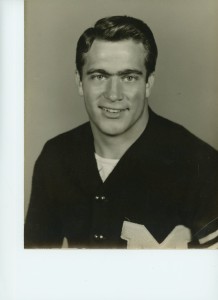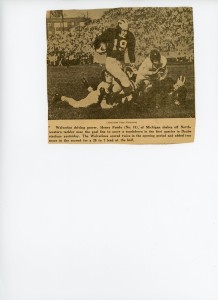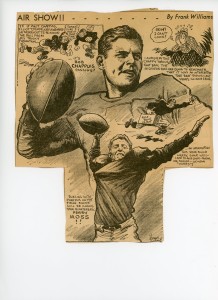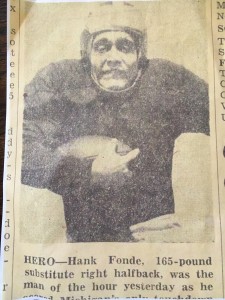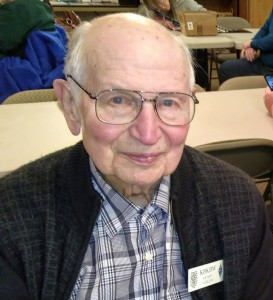BY JOEL THURTELL
Thirty-five years ago, I met a retired University of Michigan psychology professor who was in charge of admitting volunteers to the newly-formed Peace Corps in the early 1960’s. And a former Peace Corps volunteer (Togo, West Africa), I was interested in meeting Kelly. He agreed to an interview, even though he hated interviews.
John Palmisano is historian at the UM Amateur Radio Club. He discovered that Kelly and his wife Lillian were ham radio operators. He asked if I would make my Free Press stories about Lowell Kelly available. Full disclosure: I am a ham radio operator and member of UMARC. With permission of the Detroit Free Press, here are my two 1985 stories about Lowell Kelly:
Edition: STATE EDITION
Publication: DETROIT FREE PRESS
Date: 10-07-1985
Headline: JFK’S PEACE CORPS STILL ON THE JOB AT 25
Byline: JOEL THURTELL, FREE PRESS STAFF WRITER
Text: ANN ARBOR — Lowell Kelly was at the University of Michigan Oct. 14, 1960,
when presidential candidate John F. Kennedy promised to form what is now known as the Peace Corps.
Kennedy’s plane was late, recalls Kelly, who then was chairman of the University of Michigan psychology department. “He arrived at two o’clock in the morning, and it was pouring down rain.”
Kelly didn’t know it at the time, but he was soon to become part of the new federal agency as its first director of volunteer selections.
The 25th anniversary celebration of the Peace Corps, created in 1961 by the newly elected Kennedy, will be kicked off today and Tuesday on the steps of the Michigan Union, where Kennedy made his speech.
A QUARTER a century after its birth the Peace Corps still sends volunteers to underdeveloped countries, often in remote villages, to teach and to help with agricultural or other projects.
Kelly, 79, says that more specialists are being attracted to the Peace Corps now than in his era. Patrick Pietrzak, who holds the post Kelly once held, agrees.
“There is still room for the generalist in the Peace Corps, but about half of what we put in in a given year is the scarcer skills — secondary education math and science teachers, special ed teachers, foresters and skilled trades,” he said.
“The Peace Corps is not just strictly altruism,” Pietrzak said.
But Scott Munzel, a U-M law student who was a Peace Corps agricultural extension agent in Ecuador from 1981 to 1983, thinks the old attitude of idealism is still prevalent among volunteers.
“THE STEREOTYPE of the early volunteer was somebody charging off to change the world,” Munzel said. Current volunteers are “trying to do the same thing.”
Munzel thinks a volunteer today must still be innovative and adaptable. A member of the U-M Marching Band before he joined the Peace Corps, Munzel, 26, played his saxophone to break the ice with people in the Andes Mountains village of Espinel, population 500, where he was stationed.
For Munzel, being truly effective meant forgetting his own ideas about what could be accomplished and how much time a project should take.
When the locals were slow in ordering a truck to deliver concrete lids for Munzel’s village latrine project, Munzel knew he could rent a truck and finish the project himself. “But that competes with having local people learn to do it,” he said.
THE EXPERIENCES of Jon Heise, who was among the first volunteers chosen by Kelly to be a Peace Corps teacher, are much the same — even though he volunteered 23 years ago.
Munzel, who is now director of the U-M International Center, was 22 in 1962 when he was sent to teach in Harar, Ethiopia, a town of about 20,000 in an isolated mountainous region.
“We were the first white people they had even seen,” he said.
The ideal skin color to the Ethopians was a coffee-with- cream color, and white skin “was clearly unflattering,” he said.
To Heise, the fact that black Africans had prejudices about skin color “was very surprising — I didn’t expect it.”
Slowly, Heise began to notice changes in his own attitudes.
THE ETHIOPIAN standard of living was low and Heise was learning “how little was necessary for a happy and satisfying life.”
In Harar, Heise’s house was “a mix of cement, mud, animal dung, plaster, sticks and straw.” The roof was corrugated zinc.
During the rainy season, water came from a public faucet. During the dry season, Heise bought water from vendors whose donkeys carried five-gallon jerry cans from house to house.
Ethiopians, he said, “Could do with very little, and did. The quality of their life did not deteriorate” because they lacked consumer goods. “It may have been enriched. You don’t need a refrigerator to be happy,” he said.
Keywords: PEACE CORPS
Edition: METRO FINAL
Publication: DETROIT FREE PRESS
Date: 11-21-1985
Headline: AN ENEMY OF INTERVIEWS
Byline: JOEL THURTELL, FREE PRESS STAFF WRITER
Text: Lowell Kelly has been dead set against personal interviews ever since the 1930s.
The problem: Kelly, then studying in Germany, couldn’t come for the all-important job interview at an East Coast university.
In the view of the former chairman of the University of Michigan psychology department and a past president of the American Psychological Association,there’s only one time when a face-to-face meeting is important.
When you’re choosing a marriage partner.
FOR KELLY and his wife, Lillian, that’s all there was: One meeting — person-to-person, at least.
There were plenty of meetings before and after they first cast eyes on each other, but they were all by radio.
By 1936, Lowell Kelly had the job teaching psychology at the University of Connecticut. Lillian was living in Haiti, where her father was engineering roads for the United Fruit Co.
Every morning while he was having coffee, Kelly would chat with several other amateur radio operators. “Lillian was the other member” of the circle.
“I didn’t know anything about her, except that she was born in Jamaica and had an unbelievably broad British accent.”
On a trip to the United States, she visited briefly with him. Kelly said, “I thought she was very pleasant, but it never occurred to me that we would ever marry.”
Afterward, their on-the-air conversations became more intimate. To reduce eavesdropping, they began talking in high- speed Morse code.
One day, in code, he asked the big question.
And in Morse her answer came back: “Yes.”
Then her father came into the radio room. “So I popped the question to the old man,” also an experienced radio operator.
“It was the first time I ever heard his ‘fist’ tremble” at the telegraph key: ” ‘We give you our blessing.’ ”
AT 80, Kelly is retired, a resident of the Glacier Hills senior apartments at Ann Arbor. His latest project is a critique of the medical profession from a personal point of view.
Born Nov. 15, 1905, Kelly was reared on a farm in northern Indiana. Despite his practical background, he earned a doctorate in experimental psychology at Stanford University.
But the commitment to pure science didn’t last. Often, practical problems in his personal life arose, and he tried to relate them to broader social issues.
FIFTY YEARS AGO, when the dean of the University of Connecticut wrote to him in Germany to say his credentials were fine, but “never has the university hired anyone without a face-to-face interview,” Kelly began to wonder how his own experience related to society’s penchant for conducting interviews.
Kelly talked the dean into hiring him by letter and now delights in telling the fate of the university’s one other psychology professor.
Unlike Kelly, the senior psychologist was hired after the hallowed job interview, only to be sent packing after it was revealed that he had seduced a female student.
That incident prompted Kelly to do research on interviewing — “a widely
used and much trusted personnel technique. I could find no evidence of its validity,” he said, “and some studies raised doubts about it.”
IN THE 1950S, Kelly began studying U-M medical students, all of whom were accepted only after being interviewed by two members of the medical faculty’s admissions committee.
There were two pools of medical school applicants: Those who were qualified by undergraduate grades and aptitude test scores — and those who weren’t.
After three years on the Medical School admissions committee, Kelly said, “I resigned in disgust.
“The evidence was that interviews were contributing absolutely nothing to the selection process.”
Kelly’s alternative? Reject the unqualified applicants and “decide the rest on the basis of a lottery.”
But Kelly said he has lost his battle against the personal interview.
The practice remains widespread and is still in use at the U-M Medical School.
KELLY WAS the first chief of selections for the Peace Corps, but his interest in selecting people scientifically was established by the 1940s, when he devised the Navy’s system for choosing pilot trainees.
A private pilot since 1935, Kelly discovered that the Army Air Corps was selecting air cadets by measuring candidates’ physical reflexes. “I tried a completely different approach. I kept a record of those who succeeded and failed in pilot training. I had them fill out questionnaires about their likes and dislikes. If a certain response was typical of a successful trainee, it got a plus. If it was typical of failures, it got a minus.”
This way, Kelly devised “a fairly successful biographical inventory” for screening poor candidates out of training. HIS TEST eventually would be used throughout the Navy. But in the beginning, there was a problem. “A few of the people who scored very highly were washed out.”
“Ham radio came to the rescue,” he said. Kelly outfitted a training plane with an amateur radio transmitter that sent conversations between instructor and student to the ground. There, Lowell and Lillian Kelly were recording the exchanges.
“The problem was the flight instructors,” he said. “They all had learned to fly in cow pastures, taught by people who learned the same way. They didn’t know a damned thing about aerodynamics.”
A FEW Navy pilots found a way to do some testing on Kelly.
“I wanted to go through flight training, get a set of wings,” he said. But he was 37 — too old, the Navy said.
For the author of the Navy’s instructional book on instrument flying, this posed a credibility problem. He was regarded as a professor who lacked practical experience.
The following “test” of Kelly was repeated often:
The scene was a Montreal airfield. Kelly was seated with other passengers, including three admirals and four generals, in a B-24 Liberator, a four-engine heavy bomber. The plane took off for Washington, D.C.
“We’d just about gotten altitude,” Kelly said. “The pilot came back where I was sleeping.”
ASKED THE PILOT: “Would you mind flying this Liberator on to Washington?”
“I’d never been in one before, but I thought, ‘at least I’ll have a
co-pilot,’ ” Kelly recalled.
But, said Kelly, “There wasn’t a co-pilot.” He was alone in the cabin with four sets of instruments and controls for four engines. Even though he had flown small planes, this was a shock.
Kelly turned to the pilot: “At least give me a minute to figure this out.”
“Oh,” the pilot responded, “You’ll figure it out. You know how to fly on instruments.”
The pilot went back to Kelly’s seat and took a nap.
A few hours later, the B-24 with a tense Kelly at the controls approached Washington.
“The pilot was good enough to land it,” said Kelly.
Keywords: BIOGRAPHY; LOWELL KELLY
